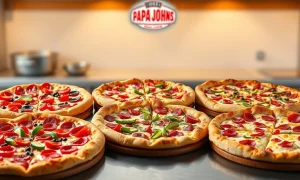The challenging economic climate has claimed another casualty. A once-celebrated high-end burger chain, known for its gourmet offerings and upscale ambiance, has officially filed for Chapter 7 bankruptcy. This decisive move signals the complete liquidation of the business, marking a stark end to its operations. For many in the business world, this development underscores the persistent vulnerabilities within the food service sector. It highlights the brutal realities of competition and economic pressures that can lead even established brands to face a devastating restaurant bankruptcy.
The Road to Restaurant Bankruptcy: Gourmet Grille’s Downfall
Initially, Gourmet Grille launched with significant fanfare. Its unique menu and premium ingredients quickly attracted a loyal customer base. The chain expanded rapidly, opening multiple locations in prime urban areas. However, this growth brought its own set of challenges. Rising operational costs, particularly for high-quality ingredients and skilled labor, began to erode profit margins. Despite its popularity, the business struggled to maintain profitability in a fiercely competitive market.
Several factors contributed to Gourmet Grille’s ultimate demise. First, the escalating cost of beef and other essential supplies significantly impacted their bottom line. Supply chain disruptions further complicated matters, causing delays and increased expenses. Second, a tight labor market led to higher wage demands and difficulties in retaining experienced staff. These combined pressures made it increasingly difficult to operate profitably. Ultimately, the company found itself in an unsustainable financial position, culminating in this painful restaurant bankruptcy.
The company also faced stiff competition. Numerous fast-casual and other high-end dining options emerged, fragmenting the market. Consumer preferences also shifted. Many diners began seeking healthier options or more value-oriented meals. Gourmet Grille, therefore, found it hard to adapt quickly enough to these evolving market dynamics. This inability to pivot effectively contributed to its financial decline.
Navigating Chapter 7: A Deep Dive into Restaurant Bankruptcy
Chapter 7 bankruptcy represents a significant legal process. It involves the liquidation of a debtor’s non-exempt assets to pay creditors. Unlike Chapter 11, which allows for reorganization, Chapter 7 means the business ceases operations. A trustee is appointed to oversee the sale of assets. Proceeds from these sales are then distributed among creditors according to legal priority.
For a business, filing Chapter 7 is often a last resort. It indicates that the company sees no viable path to recovery or reorganization. This type of restaurant bankruptcy results in the permanent closure of all locations. Employees lose their jobs, and the brand essentially disappears from the market. Creditors, including suppliers, landlords, and lenders, typically recover only a fraction of what they are owed. This process can be lengthy and complex, but it provides a clear legal framework for winding down an insolvent entity.
Key aspects of Chapter 7 include:
- Asset Liquidation: All valuable company assets, such as kitchen equipment, furniture, and intellectual property, are sold.
- Trustee Appointment: A court-appointed trustee manages the liquidation process.
- Debt Discharge: Eligible debts are discharged, providing a clean slate for the owners, though the business itself ceases to exist.
- No Reorganization: The focus is on asset distribution, not on restructuring the business for continued operation.
This path is chosen when the business is beyond rescue. It signifies a complete surrender to insurmountable financial challenges. Consequently, it brings finality to the company’s financial woes.
Economic Headwinds and Restaurant Bankruptcy Trends
Gourmet Grille’s situation is not isolated. The broader restaurant industry has faced significant economic headwinds in recent years. Inflationary pressures have driven up the cost of food, labor, and utilities. Consumers, meanwhile, have become more cautious with discretionary spending. This creates a difficult environment for many establishments, particularly those in the high-end segment.
The post-pandemic landscape has also reshaped dining habits. Many consumers continue to prioritize takeout and delivery, impacting dine-in revenues. Furthermore, the rise of ghost kitchens and virtual brands has intensified competition. These new models often operate with lower overheads, posing a threat to traditional brick-and-mortar restaurants. Therefore, traditional restaurants must adapt or risk falling behind. The challenges are particularly acute for businesses with high fixed costs.
Recent data underscores these trends. Industry reports show an increase in restaurant closures across various segments. Small, independent restaurants are particularly vulnerable. However, larger chains, like Gourmet Grille, are not immune. The current economic climate demands extreme resilience and adaptability from restaurant operators. Without these qualities, the risk of restaurant bankruptcy remains high for many.
Factors contributing to industry struggles:
- Rising Operating Costs: Ingredients, labor, rent, and utilities are all increasing.
- Shifting Consumer Behavior: More takeout/delivery, value-seeking, and health-consciousness.
- Intense Competition: From new formats like ghost kitchens and established players.
- Labor Shortages: Difficulty finding and retaining staff, leading to higher wages.
These elements collectively create a perfect storm for many food service businesses. Consequently, many are struggling to stay afloat.
Impact on Stakeholders: Employees, Creditors, and the Brand
The filing of Chapter 7 bankruptcy has immediate and severe consequences for all stakeholders. Employees are perhaps the most directly affected. They face sudden job loss, often with little to no notice or severance. This can be devastating for individuals and their families. Many employees, moreover, may have dedicated years to the company, making the closure even more painful.
Creditors also face significant losses. Secured creditors, such as banks holding mortgages on property, have the highest priority. However, unsecured creditors, including food suppliers, utility companies, and landlords, typically recover only a small percentage of their outstanding debts, if any. The liquidation process prioritizes certain claims over others. Therefore, many will not be fully repaid.
The brand itself ceases to exist as an operating entity. While the intellectual property, like recipes or the brand name, might be sold as assets, the operational business is gone. This impacts not only the owners but also the broader community. A popular restaurant often serves as a local hub. Its closure leaves a void in the community. The ripple effects extend beyond just the financial aspects of the restaurant bankruptcy.
Ultimately, the impact of a Chapter 7 filing is widespread. It affects individuals, other businesses, and the local economy. The finality of this process leaves little room for recovery or a second chance for the business itself.
Lessons for Entrepreneurs Amidst Restaurant Bankruptcy Challenges
Gourmet Grille’s unfortunate end offers crucial lessons for other entrepreneurs, especially those in the food service industry. Firstly, robust financial planning and strict cost control are paramount. Businesses must closely monitor their expenses, particularly variable costs like ingredients and labor. Unchecked spending can quickly lead to financial distress.
Secondly, adaptability is key. The market is constantly evolving. Businesses must be willing to pivot their strategies, menus, or operational models in response to changing consumer demands and economic conditions. Remaining rigid in the face of change can be fatal. For instance, exploring new revenue streams, like catering or meal kits, might have offered alternative paths for Gourmet Grille.
Furthermore, understanding the competitive landscape is vital. New entrants and shifting trends can quickly disrupt established businesses. Continuous market research helps businesses stay ahead. It allows them to identify threats and opportunities. Ultimately, proactive management of these elements can help prevent a similar restaurant bankruptcy. Learning from the failures of others provides valuable insights for sustained success.
Key takeaways for businesses:
- Financial Vigilance: Maintain tight control over all expenses and cash flow.
- Market Adaptability: Be prepared to change menus, services, or business models.
- Competitive Awareness: Continuously monitor competitors and industry trends.
- Strong Leadership: Make difficult decisions early to avoid deeper crises.
These principles are fundamental for navigating the complexities of modern business. Ignoring them can lead to dire consequences.
The Future After the Filing
With the Chapter 7 filing, Gourmet Grille’s physical locations will be liquidated. Its assets, including kitchen equipment, fixtures, and potentially its brand name or recipes, will be sold off by the bankruptcy trustee. This process aims to maximize recovery for creditors. However, it means the end of Gourmet Grille as a functioning entity. The brand, as consumers knew it, will cease to exist.
The closure also frees up prime real estate. Other restaurateurs may now look to acquire these locations. This could lead to new businesses emerging in the same spaces, potentially bringing fresh concepts to the market. While one chapter closes, another often begins for the physical properties involved. The market, therefore, tends to adjust and fill the void. This natural cycle of business failure and new ventures continues to shape the economic landscape. The restaurant bankruptcy, while tragic for some, creates opportunities for others.
Ultimately, Gourmet Grille’s story serves as a cautionary tale. It highlights the immense challenges faced by businesses, even those with initial success and a strong concept. The food industry remains dynamic and demanding. Only the most agile and financially disciplined operations can truly thrive in such an environment. This recent filing, consequently, offers a stark reminder of these realities. It underscores the importance of resilience and strategic foresight in a challenging economic climate.
Frequently Asked Questions (FAQs)
1. What is Chapter 7 bankruptcy for a business?
Chapter 7 bankruptcy, also known as liquidation bankruptcy, is a legal process where a business ceases operations. A court-appointed trustee sells all non-exempt assets to pay off creditors. The company’s debts are then discharged, and the business is dissolved. This differs significantly from Chapter 11, which allows for business reorganization and continued operation.
2. Why would a high-end burger chain file for Chapter 7?
A high-end burger chain might file for Chapter 7 when it faces insurmountable debt and sees no realistic path to financial recovery or reorganization. This typically happens due to a combination of factors, including high operating costs (ingredients, labor, rent), declining sales, intense competition, and an inability to adapt to changing market conditions. It signifies a complete inability to meet financial obligations.
3. What happens to employees when a restaurant files Chapter 7 bankruptcy?
When a restaurant files for Chapter 7, all employees are typically laid off immediately. The business ceases operations, and there is no ongoing employment. Employees usually become unsecured creditors for any unpaid wages or benefits, meaning they may recover only a small portion, if any, of what they are owed after secured creditors are paid.
4. How does this restaurant bankruptcy impact the food industry?
This specific restaurant bankruptcy underscores the broader challenges facing the food industry, including inflation, labor shortages, and shifting consumer preferences. It serves as a stark reminder that even well-known brands are vulnerable to economic pressures. It may prompt other businesses to re-evaluate their financial strategies, cost controls, and adaptability to market changes.
5. Can the ‘Gourmet Grille’ brand ever return?
While the operating business is dissolved in Chapter 7, the brand’s intellectual property (like its name, recipes, or logos) might be sold as an asset during liquidation. If purchased by another entity, there is a theoretical possibility that the brand could be revived in some form in the future. However, it would be under new ownership and management, essentially a new business entity operating under the old name.
6. What lessons can other restaurant owners learn from this situation?
Other restaurant owners can learn several vital lessons. These include the critical importance of rigorous financial management, maintaining strict cost controls, and building robust cash reserves. Additionally, they should prioritize market adaptability, continuously monitoring consumer trends and competitive landscapes. Strong leadership and the ability to make difficult decisions early are also crucial for long-term survival in the volatile restaurant industry.
























